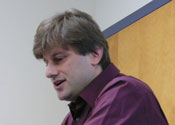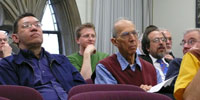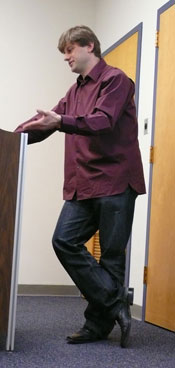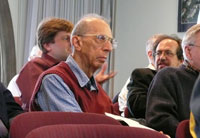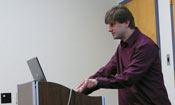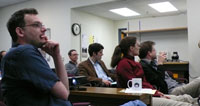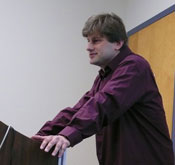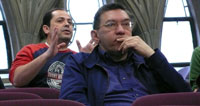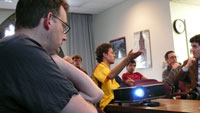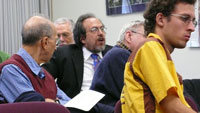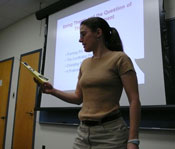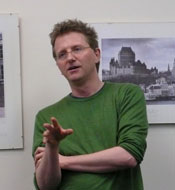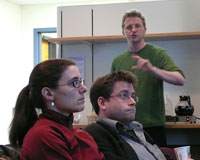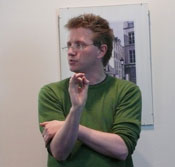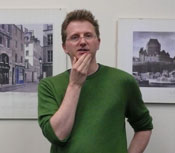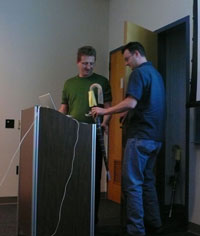

![]()
::: postdoc fellowships
::: senior fellowships
::: resident fellowships
::: associateships
![]()
being here
::: visiting
::: the last donut
::: photo album
::: center home >> being here >> last donut? >> 11 april 2008 |
Friday, 11 April 2008 Those of us who work on general relativity, Einstein's great theory of gravity, are used to hearing an interesting argument in its favor. It is, we are assured, a theory of such internal simplicity and beauty that it just has to be right. I've never really protested the argument on the self-serving grounds that any friend of a friend must be my friend too. However the argument has always unsettled me a little. It depends on an aesthetic experience that only an initiate into the arcana of general relativity can have. General relativity had seemed anything but simple and beautiful, when I first tried to penetrate it. Newton's simple linear field equation was now replaced by ten coupled differential equations whose solution, even in simple cases, was a feat of mathematics. The aesthetic appreciation grew, however, much as, I suppose, one could learn to like escargot and pureed spinach. How reliable are such experiences? What is someone to think who fails to experience the wonder? I was afraid of ever having to resolve that mess! Of course we have not had to decide for or against general relativity on this aesthetic basis. It has a few, powerful empirical successes. The best know and the most telling is the theory's ability to deliver exactly the 43 missing seconds of arc in Mercury's orbit of the sun. The moment that number appeared on the page was unforgettable for Einstein in November 1915. Forty three was the secret password that could be known only to the true theory, now knocking at his door. Einstein had his empirical success. What if a theory had no experimental success but its proponents were equally sure it was the right way? That is our present situation. String theory is a wildly popular theory of fundamental particles that, its proponents assure us, has every chance of being the final theory of everything. No theory this simple or beautiful could fail, they tell us. Experiment, they hope, will eventually speak in its favor. In the meantime, however, we should invest our time, energy and resources in the theory, since proper exposure to it leaves you in no doubt of it.
We scheduled a workshop for the morning. Lee agreed to schedule his flights so he could attend. It seemed appropriate to pick a name for the event that would lighten its gravity. It was not easy to find. The candidate names were written on our lounge whiteboard in a huge table that grew the more we thought about it. They were put to a vote with anyone eligible to vote just if they cared enough to have an opinion. The votes went up and, as the present title attracted more votes, I noticed some early opponents quietly changing their vote. All it took was a moment with an eraser and marker.
Richard is from Vienna and has a gentle and endearing manner. The last thing he would want to do in private conversation or public speaking is make you feel the slightest discomfort. Calling up my own experience of Vienna and the Viennese, I thought that this is best of old world Vienna, where politeness, cordiality and hospitality were prized. There were other parts of that old world that I prized less. Each Viennese gentleman of the old school would casually insert mention of literature, art, music and the like to display the full integration of his thought into the best culture. It would always be an integration more complete than yours. I noted with approval that Richard has never mentioned an opera in our academic discussions.
The issues for Richard were methodological. He granted the well-known troubles of string theory: its lack of empirical support, its incompleteness as a theoretical structure. Nonetheless, string theory is strongly trusted by its proponents. Recalling content from a talk he had given in January, they depended on just how much power we accord to experimental evidence in our decision. We should, he believed, adjust our notions of theory appraisal so that strong trust in string theory can arise from purely theoretical considerations without the need for empirical successes. There were also sociological issues. To what extent was the success of string theory among its proponents a kind of "groupthink," to use the term Richard borrowed from Lee Smolin. That possibility was quite familiar to me. A few years ago I had heard a noted string theorist speak and was quite appalled at a delivery that now seems little different from a carnival barker promising impossible wonders to anyone who would give him 25 cents. Then Richard delivered the novel twist. This sociological argument could be inverted, Richard pointed out. To string theorists, the critics simply lacked vision and courage. The critics were the ones who "don't get it." They are using a sociological excuse to avoid debate. There would always be those who would find a hundred reasons not to voyage to the new world. How could they be assured that there is no edge to fall off and real wonders to be discovered? Question time was surreal. It opened in the usual way with everyone taking their turn. It was a democracy in which king and commoner took their turn, indifferent to their status. Lee Smolin was third in the queue and I'll admit to some impatience as I waited to hear how he would react. Would he tackle the methodological issues Richard had raised? Would he reopen the sociological issues? Would he be measured or mean?
Perhaps sensing that we expected some reaction to the sociological remarks, Lee rewarded us with a little history. The first draft of his Trouble with Physics criticized string theory without any mention of sociological issues. He had initially rejected "groupthink." It was only at his editor's insistence that "groupthink" entered. His experience of the book's reception had now convinced him that these sociological issues were relevant. Lee's trajectory was perpendicular to Richard's and I could see little hope that they would meet. His manner, however, was as cordial as Richard's and I could see that the lunch to which I'd shortly take them would be heated only by the spices in our food.
It was a simple thought, but a wonderfully refreshing one. Nick had done the hard work for us and delved into string theory looking for other issues. There he'd settled on the topic of dualities. Through them one takes a physical system and maps each of its quantities onto those of another system. The map may initially make no sense at all. Distances may map into inverse distances; and positions may become momenta. The map is chosen simply so that the mapped quantities carry all the same relations as the originals; in that sense, they have become clones of the original. What are we to make of these clones? They are, of course, physically different. A position does not become a momentum just because of the map. But if they are different, in what property does the difference inhere? Every property of the original has its dual property in the clone.
John D. Norton |
